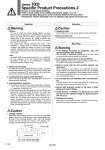Series VXD Specific Product Precautions 2 Be sure to read before handling. Refer to front matter 41 for Safety Instructions, pages 17 to 19 and the Operation Manual for 2 Port Solenoid Valves for Fluid Control Precautions. Please download it via our website, http://www.smcworld.com Selection Selection Warning 4. Ambient environment Use within the operable ambient temperature range. Check the compatibility between the product’s composition materials and the ambient atmosphere. Be certain that the fluid used does not touch the external surface of the product. 5. Countermeasures against static electricity Take measures to prevent static electricity since some fluids can cause static electricity. 6. Low temperature operation 1) The valve can be used in an ambient temperature of between .10 to .20°C. However, take measures to prevent freezing or solidification of impurities, etc. 2) When using valves for water application in cold climates, take appropriate countermeasures to prevent the water from freezing in tubing after cutting the water supply from the pump, by draining the water, etc. When warming by a heater, etc., be careful not to expose the coil portion to a heater. Installation of a dryer, heat retaining of the body is recommended to prevent a freezing condition in which the dew point temperature is high and the ambient temperature is low, and the high flow runs. The use of a fluid that contains foreign objects can cause problems such as malfunction and seal failure by promoting wear of the valve seat and armature, and by sticking to the sliding parts of the armature etc. Install a suitable filter (strainer) immediately upstream from the valve. As a general rule, use 80 to 100 mesh. The supply water includes materials that create a hard sediment or sludge such as calcium and magnesium. Sediment and sludge can cause the valve to not operate properly. Therefore, install a water softening device, which removes these materials, and a filter (strainer) directly in front of the valve. Generally, FKM is used as seal material, as it is resistant to oil. The resistance of the seal material may deteriorate depending on the type of oil, manufacturer or additives. Check the resistance before using. AC coil: 5% or less of rated voltage DC coil: 2% or less of rated voltage Caution Caution 1. Leakage voltage Particularly when using a resistor in parallel with a switching element and using a C-R element (surge voltage suppressor) to protect the switching element, take note that leakage current will flow through the resistor, C-R element, etc., creating a possible danger that the valve may not turn off. 2. Selecting model Material depends on fluid. Select optimal models for the fluid. 3. When the fluid is oil. The kinematic viscosity must not exceed 50 mm2/s. R SOL. OFF Switching element C Leakage current Power supply Leakage voltage Mounting Warning 1. If air leakage increases or equipment does not operate properly, stop operation. After mounting is completed, confirm that it has been done correctly by performing a suitable function test. 2. Do not apply external force to the coil section. When tightening is performed, apply a wrench or other tool to the outside of the piping connection parts. 3. Mount a valve with its coil position upward, not downward. When mounting a valve with its coil positioned downward, foreign objects in the fluid will adhere to the iron core leading to a malfunction. Especially for strict leakage control, such as with vacuum applications and non-leak specifications, the coil must be positioned upward. 4. Do not warm the coil assembly with a heat insulator etc. Use tape, heaters, etc., for freeze prevention on the piping and body only. They can cause the coil to burn out. 5. Secure with brackets, except in the case of steel piping and copper fittings. 6. Avoid sources of vibration, or adjust the arm from the body to the minimum length so that resonance will not occur. 7. Painting and coating Warnings or specifications printed or labeled on the product should not be erased, removed or covered up. A 148
